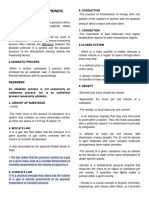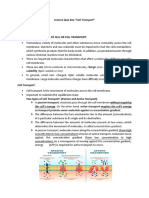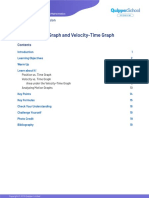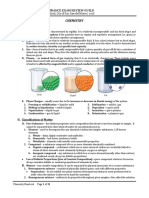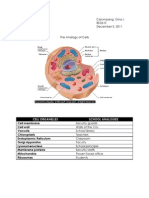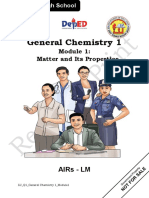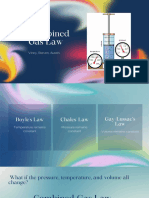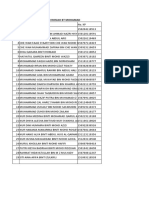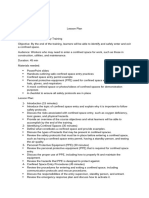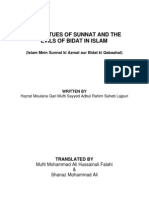Gas Laws Reviewer
Gas Laws Reviewer
Uploaded by
Mhehycel GadonCopyright:
Available Formats
Gas Laws Reviewer
Gas Laws Reviewer
Uploaded by
Mhehycel GadonCopyright
Available Formats
Share this document
Did you find this document useful?
Is this content inappropriate?
Copyright:
Available Formats
Gas Laws Reviewer
Gas Laws Reviewer
Uploaded by
Mhehycel GadonCopyright:
Available Formats
Chemistry Gases
Reviewer
One of the criteria that scientists use to assess the probability of the existence of life on other
planets is the presence of a habitable atmosphere. Lucky for us, the Earth’s atmosphere is one
in a million (if not billion), that’s why we're able to live on what we call the blue planet.
An atmosphere is defined as the layers of gases that surround any planet in general. Here on
Earth, the composition of our troposphere (lowermost layer of the atmosphere) is most suitable
to support life. In this module, we will tackle the third state of matter, gases, and the laws
governing their behavior.
The Concept of Ideal Gas
Let us do an experiment first before we discuss this topic.
Put your palm near your mouth, and with your mouth wide open, try to blow some air towards
your palm. How does it feel? Does it feel hot or cold? Next, try to pout, and again, with your
palm near your mouth, blow some air into it. How does it feel now? It feels colder, right?
This phenomenon is called the Joule-Thomson expansion; your breath feels cooler as it
passes through a smaller exit because the air in your breath behaves like a real gas. If your
To get more Chemistry review
materials, visit To God be the glory!
https://filipiknow.net/chemistry-re
view/
Chemistry Gases
Reviewer
breath behaves as an ideal gas, there will be no difference in the temperature of the gas
between the two scenarios that we did.
For a gaseous system to become ideal, there are four conditions that must be satisfied first, and
these are the following:
1. The gas particles have negligible volume.
2. The gas particles are equally sized and do not interact with neighboring gas particles.
3. The gas moves in a random motion.
4. Collisions between gas particles are perfectly elastic.
As you can see from these assumptions, it is almost impossible to have an ideal (or perfect)
gas, right? That’s true, but we can “force” the gas to behave ideally under low-pressure and
high-temperature conditions.
Low pressure means that the gas occupies a large volume, and high temperature provides high
kinetic energy to gas molecules, which can minimize the interactive forces between gas
molecules. Furthermore, the use of gases with low molar mass (such as H2 gas) can further
promote ideal behavior. In this section, we will deal with equations that describe the properties
of ideal gases.
Empirical Gas Laws
1. Boyle’s Law
To get more Chemistry review
materials, visit To God be the glory!
https://filipiknow.net/chemistry-re
view/
Chemistry Gases
Reviewer
When you were a child, did you also try to push the plunger of a needleless syringe while
sealing the exit with your finger? Back then, my goal was to push the plunger all the way to the
tip of the syringe, not knowing that there is air inside which prevents me from doing so.
Fast forward to my high school days, during my Chemistry class, I recalled this experiment of
mine and realized, “AHA, it's Boyle’s Law!”
Boyle’s law relates the pressure and volume of an ideal gas under constant temperature. It
states that at a constant temperature, the pressure of a fixed amount of gas is inversely
proportional to the volume of the gas.
If you also did the syringe experiment, try to recall that the plunger becomes harder to push as
the tip of the plunger approaches the tip of the syringe. This is because pushing the syringe
further decreases the volume occupied by the gas, which results in an increased pressure
exerted by the gas towards the plunger.
To get more Chemistry review
materials, visit To God be the glory!
https://filipiknow.net/chemistry-re
view/
Chemistry Gases
Reviewer
Quite amazing, right? We didn’t know back then that at such a young age, we already
demonstrated Boyle's law!
Although we demonstrated it using a syringe, Robert Boyle, a British chemist and natural
philosopher, demonstrated this phenomenon in the 17th century by using a bent glass tube and
mercury. By virtue of this law, it can be said that for a given sample of gas under two different
sets of conditions, the relationship between its pressure and volume before and after the
change is given as
where P is the pressure, and V is the volume of the gas under the two different sets of
conditions. Keep in mind that this formula is valid only under constant temperature, and as long
as the amount of the gas does not change.
MNEMONIC: Boyle’s Law is the first of the numerous gas laws that you will encounter. To easily
recall what parameter is constant in Boyle’s law, just remember BOYLET (Boyle’s Law, constant
T!)
Sample Problem:
A sample of oxygen gas exerts a pressure of 2.50 atm in a 20.0 L container. What will be the
new pressure it will exert if all of it will be transferred to a 16.0 L container at constant
temperature? Assume that the gas behaves ideally.
Solution:
Initially, the volume occupied by the gas is 20 L and exerts a pressure of 2.50 atm. Since the
temperature and the amount of gas are constant, and the gas was assumed to behave ideally,
we can use Boyle's law to solve the new pressure after it was transferred to a 16 L container.
To get more Chemistry review
materials, visit To God be the glory!
https://filipiknow.net/chemistry-re
view/
Chemistry Gases
Reviewer
Therefore, the new pressure is 3.125 atm.
2. Charles’s and Gay-Lussac’s Law
After Robert Boyle successfully established the relationship between volume and pressure in
gases, one question arose:
Why does the pressure-volume relationship hold true only at constant temperature?
This was answered in the early 19th century by the separate work of Jacques Alexandre Cesar
Charles and Joseph Louis Gay-Lussac. Their studies showed that at constant pressure, there
exists a linear relationship between temperature and the volume of gases. Meaning, a certain
To get more Chemistry review
materials, visit To God be the glory!
https://filipiknow.net/chemistry-re
view/
Chemistry Gases
Reviewer
amount of gas expands when heated, and contracts when cooled. Their separate work led to
the development of Charles’s and Gay-Lussac’s law or simply, Charles’s law, which states
that the volume of a fixed amount of gas maintained at constant pressure is directly proportional
to the absolute temperature of the gas.
The mathematical expression of Charles’ law will lead to the derived equation
where V1 and T1 are the initial volume and temperature, while V2 and T2 are the final volume and
temperature, respectively.
When working with temperatures in gas laws, make sure that the temperature is always on the
Kelvin scale, as it was clearly stated in the law that the proportionality was associated with the
absolute temperature of the gas. Use the formula below to convert temperatures in ℃ to Kelvin.
T (in K) = T (in ℃) + 273
This observation can be explained by the expansion of the gas. As the temperature increases,
the kinetic energy of gas molecules increases, which causes the gas to exert more pressure
To get more Chemistry review
materials, visit To God be the glory!
https://filipiknow.net/chemistry-re
view/
Chemistry Gases
Reviewer
against the container. However, since the pressure is constant, the increase in pressure applied
by the gas is manifested as an increase in the volume occupied by the gas.
Now, what if we let the expanding gas exert more pressure on its container while keeping the
volume occupied by the gas constant? Doing so will lead us to the alternative form of Charles’s
law, which some references call the Gay-Lussac’s law or the Amonton’s law. This relates the
pressure and temperature of a fixed amount of gas under constant volume conditions and is
mathematically expressed as:
where P1 and T1 are the initial volume and pressure, while P2 and T2 are the final volume and
pressure, respectively.
MNEMONICS: To avoid confusion on which property is constant, you can just remember
CHARLEP (Charles’ Law, constant Pressure).
3. Avogadro’s Law
Now, what if at constant temperature and pressure, we add a certain amount of gas to the
system? What do you think will happen?
Well, in this respect, let’s just say that ideal gases are like your clothes. When you have so
many clothes that they don’t fit your wardrobe anymore, normally, you (although most probably,
it will be your mother) transfer your clothes to a larger wardrobe, right?
The same is true for ideal gases. If you increase the amount of gas under constant temperature
and pressure conditions, the tendency of the gas is to increase its volume. This is known as
Avogadro's law, named after Italian chemist Lorenzo Romano Amedeo Carlo Avogadro.
To get more Chemistry review
materials, visit To God be the glory!
https://filipiknow.net/chemistry-re
view/
Chemistry Gases
Reviewer
Avogadro’s law states that at constant temperature and pressure, the volume of a gas is
directly proportional to the number of moles of gas present. The mathematical expression of
Avogadro’s law will lead to the derived equation.
where V1 and n1 are the initial volume and number of moles, while V2 and n2 are the final volume
and number of moles, respectively.
Sample Problem:
What amount of an ideal gas must be added to double the volume occupied by the same gas
with an initial amount of 0.25 moles under constant temperature and pressure?
Solution:
Since the system is subjected to constant temperature and pressure, we can use Avogadro's
law to solve this problem. However, we are not given the initial volume. For such cases, we can
use arbitrary volume.
We want to compute the amount of gas that needs to be added so that the volume will be
doubled. Hence, if we arbitrarily select V1 = 1.0 L, then V2 = 2.0 L. We are given the n1, hence,
we can already solve the problem.
To get more Chemistry review
materials, visit To God be the glory!
https://filipiknow.net/chemistry-re
view/
Chemistry Gases
Reviewer
Although we got 0.50 mol as the final answer, this number does not answer our question. We
were asked what amount of the gas must be added to double the volume that the gas will
occupy. Initially, there’s 0.25 mol of gas. To double the volume, the amount of the resulting gas
should be 0.50 mol. Hence, we need to add 0.25 mol of the same gas to the system.
4. Combined Gas Law
So far, we have considered cases wherein two variables are always constant. However, there
are cases wherein the volume, temperature, and pressure all change at the same time. In such
cases, the combined gas law can be used.
The combined gas law was obtained by combining Boyle's law, Charles' law, and Amonton's
law. This law expresses the relationship between the volume, pressure, and absolute
temperature of a fixed amount of gas. The mathematical expression of the combined gas law
will lead to the derived equation shown below.
Sample Problem:
A fixed amount of an ideal gas is being compressed to half of its original volume. If initially, the
gas exerts 1.5 atm at a temperature of 300 K, what would be the ratio of final temperature over
the final volume after compression if the pressure becomes 2.0 atm?
Solution:
It was stated that only the amount of gas is constant. Hence, we should use the combined gas
law.
To get more Chemistry review
materials, visit To God be the glory!
https://filipiknow.net/chemistry-re
view/
Chemistry Gases
Reviewer
Since the gas is being compressed to half of its initial volume, and there is no initial volume
given, then we can assign arbitrary values. For simplicity, we let V1 = 2.0 L and V 2 = 1.0 L.
Furthermore, P1 = 1.5 atm, T1 = 300 K, and P2 = 2.0 atm.
Using the combined gas law:
What we have so far is the ratio of the final volume over the final temperature. However, we are
asked to determine the ratio of final temperature over the final volume. We can get this by
getting the reciprocal of the equation above, which gives us
Ideal Gas Equation
The ideal gas equation accounts for the behavior of all ideal gas. This equation relates the
pressure, absolute temperature, volume, and amount of the gas. This means that if we know
three out of four properties of the gas, then we can compute the missing property using the ideal
gas equation.
The mathematical expression of the ideal gas expression is shown below:
To get more Chemistry review
materials, visit To God be the glory!
https://filipiknow.net/chemistry-re
view/
Chemistry Gases
Reviewer
PV = nRT
R is known as the universal gas constant, which is equal to 0.0821 L⦁atm/mol⦁K, or 8.314
J/mol⦁K
IMPORTANT NOTE: A mole of ideal gases, regardless of identity, occupies a molar volume of
22.414 L at 273.15 K (or 0 ℃) with a pressure of 1 atm. This temperature and pressure
condition is known as the standard temperature and pressure (STP). Another benchmark
condition is known as the standard ambient temperature and pressure (SATP). At SATP, the
temperature is 298.15 K (or 25 ℃) and the pressure is 1 bar.
Sample Problem:
Write an expression that will allow us to determine the volume occupied by 0.67 mol SF6 (146
g/mol) at SATP if it behaves as an ideal gas.
Solution:
Obviously, we need to use the ideal gas equation to be able to address this problem. To easily
visualize the problem, let us first list what is known to us.
● R = 0.0821 L⦁atm/mol⦁K
● n = 0.67 mol
● T = 298.15 K
● P = 1 bar
Remember that we are asked to write an expression that will enable us to solve the volume of
the gas. Hence, the units of the given that we need to use should cancel each other out.
If we are to use R = 0.0821 L⦁atm/mol⦁K, this means that the unit of amount should be in mole,
the unit of temperature should be in Kelvin (K), and the unit of pressure should be in
atmosphere (atm). That being said, we need to convert 1 bar to atm first. We know that 1 atm =
1.01325 bar. Therefore:
To get more Chemistry review
materials, visit To God be the glory!
https://filipiknow.net/chemistry-re
view/
Chemistry Gases
Reviewer
Then, from the ideal gas equation:
To get more Chemistry review
materials, visit To God be the glory!
https://filipiknow.net/chemistry-re
view/
You might also like
- 06 LabActivityForm BigBangBalloon PDFDocument4 pages06 LabActivityForm BigBangBalloon PDFLaurice Anne Zapanta0% (1)
- Lewis Dot Structures and VSEPRDocument35 pagesLewis Dot Structures and VSEPRMenna GalalNo ratings yet
- (Q1) MODULE 7 - Percentage Yield PDFDocument16 pages(Q1) MODULE 7 - Percentage Yield PDFJewel SantiagoNo ratings yet
- Thermodynamics ReviewerDocument5 pagesThermodynamics ReviewerJohn Herald MandigmaNo ratings yet
- Percent Composition and FormulasDocument15 pagesPercent Composition and FormulasJosh CRNo ratings yet
- SLM General Physics 1 2ndWkDocument20 pagesSLM General Physics 1 2ndWkJovet QuiñonesNo ratings yet
- GeneralChemistry1 Q1 Mod4 Chemical-Formulas Ver-5Document21 pagesGeneralChemistry1 Q1 Mod4 Chemical-Formulas Ver-5JESSAMEN DOLORICAN100% (1)
- General Chemistry 2: Quarter 1-Module 3Document31 pagesGeneral Chemistry 2: Quarter 1-Module 3Niño Edrianne NimoNo ratings yet
- NRSL GasLawsDocument48 pagesNRSL GasLawsBrenda Aquino100% (1)
- Formation & Structure of PolymersDocument6 pagesFormation & Structure of PolymersBensonjr Magaway De OcampoNo ratings yet
- LESSON 1.2 Coulombs LawDocument48 pagesLESSON 1.2 Coulombs LawKryssha GabietaNo ratings yet
- General Physics 1: Self-Regulated Learning Module inDocument20 pagesGeneral Physics 1: Self-Regulated Learning Module inOmar Adil100% (1)
- General Chemistry 1: Topic: The Quantum Mechanical Description of The Atom and It'S Electronic StructureDocument11 pagesGeneral Chemistry 1: Topic: The Quantum Mechanical Description of The Atom and It'S Electronic StructureJennette BelliotNo ratings yet
- Gen Chem 1 Q1 M 5-6Document12 pagesGen Chem 1 Q1 M 5-6Joselito UbaldoNo ratings yet
- General Chemistry 2: Third Quarter-Module 2Document18 pagesGeneral Chemistry 2: Third Quarter-Module 2Jezysaint Ruth Del SocorroNo ratings yet
- General Physics 1 (Module 3)Document5 pagesGeneral Physics 1 (Module 3)Jhunner BuanNo ratings yet
- Adm General Chemistry 2 Module 4 6 Fourth QuarterDocument32 pagesAdm General Chemistry 2 Module 4 6 Fourth Quarterlalaluuu minNo ratings yet
- Subject Area: General Chemistry 2 S.Y. 2020-2021: Sto. Domingo National Trade SchoolDocument3 pagesSubject Area: General Chemistry 2 S.Y. 2020-2021: Sto. Domingo National Trade SchoolMark Allen LabasanNo ratings yet
- Egg Osmosis Lab 1Document6 pagesEgg Osmosis Lab 1api-603235637100% (1)
- Physical Science 11 Module 3 Intermolecular ForcesDocument17 pagesPhysical Science 11 Module 3 Intermolecular ForcesHope GaldoNo ratings yet
- Physical Science ReviewerDocument2 pagesPhysical Science ReviewerKaren Joy BaloloNo ratings yet
- Module 5 - Crystalline and Amorphous SolidsDocument3 pagesModule 5 - Crystalline and Amorphous Solidsmm.vince21100% (1)
- Module 12 Mechanical Properties of MatterDocument31 pagesModule 12 Mechanical Properties of MatterMelvin Cabonegro100% (3)
- Center of Mass, Momentum, Impulse and Collision: Learning CompetenciesDocument7 pagesCenter of Mass, Momentum, Impulse and Collision: Learning CompetenciesNathalie SerafinNo ratings yet
- Cell Transport ReviewerDocument9 pagesCell Transport ReviewerNa LuNo ratings yet
- Core-Physical Science Q1 SLM - 6Document17 pagesCore-Physical Science Q1 SLM - 6Michael Marjolino EsmendaNo ratings yet
- (Q1) MODULE 10 - Gas Stoichiometry PDFDocument18 pages(Q1) MODULE 10 - Gas Stoichiometry PDFJewel SantiagoNo ratings yet
- Position Velocity vs. Time GraphDocument21 pagesPosition Velocity vs. Time Graphlea pagusaraNo ratings yet
- Quantum NumbersDocument4 pagesQuantum NumbersAly HannahNo ratings yet
- Genchem1-Week2 ModuleDocument10 pagesGenchem1-Week2 Moduleian babiloniaNo ratings yet
- STEM Module WEEK 2.1Document11 pagesSTEM Module WEEK 2.1ha ruNo ratings yet
- General Chemistry 2 Module 1Document27 pagesGeneral Chemistry 2 Module 1Kate PedritaNo ratings yet
- Chapter 3 - Electronic Structure of AtomsDocument9 pagesChapter 3 - Electronic Structure of AtomsAbrienne CaprichoNo ratings yet
- Chem HandoutDocument11 pagesChem HandoutEllen Mae PrincipeNo ratings yet
- B3 Biological MoleculesDocument10 pagesB3 Biological Moleculesingrid sihombingNo ratings yet
- Gen Chem2 Module 1 (Q2)Document16 pagesGen Chem2 Module 1 (Q2)Edgardo RoperezNo ratings yet
- N Phy 2. LAS NO. 1Document13 pagesN Phy 2. LAS NO. 1kristine lorenteNo ratings yet
- Analogy of CellsDocument3 pagesAnalogy of CellsGino Calumpang100% (1)
- GenChem2 Module 6Document16 pagesGenChem2 Module 6nurfaidzaaNo ratings yet
- 8 Gaseous StateDocument14 pages8 Gaseous StateAngelocker RenaciaNo ratings yet
- Chemistry-Differeng Laws of GasesDocument7 pagesChemistry-Differeng Laws of GasesMayette TrinidadNo ratings yet
- Science10 Q4 Mod1 BoyleslawDocument17 pagesScience10 Q4 Mod1 BoyleslawPrincess PanulayaNo ratings yet
- Phy1 11 - 12 Q1 0603 PF FDDocument68 pagesPhy1 11 - 12 Q1 0603 PF FDhiroNo ratings yet
- Week 7: Dalton'S Law of Partial PressuresDocument16 pagesWeek 7: Dalton'S Law of Partial PressuresLeonilo Olanda JrNo ratings yet
- Bioenergetics: Energy FlowDocument22 pagesBioenergetics: Energy FlowKem John SumbranaNo ratings yet
- Q3 M1 Electric ChargeDocument6 pagesQ3 M1 Electric ChargeShielami SarapuddinNo ratings yet
- GenChem1 Q1 Mod1Document32 pagesGenChem1 Q1 Mod1Roilan AmbrocioNo ratings yet
- Oxidation - Reduction (Redox) ReactionDocument10 pagesOxidation - Reduction (Redox) ReactionJa FuentesNo ratings yet
- Quarter 2 Gas LawsDocument35 pagesQuarter 2 Gas LawsajimatanogNo ratings yet
- G12 Unit and MeasurementsDocument19 pagesG12 Unit and MeasurementsAlgerd MoscosaNo ratings yet
- Gen Chem 1 Quarter 2 Module 6 Colored PDFDocument15 pagesGen Chem 1 Quarter 2 Module 6 Colored PDFAndry Eloise JacaNo ratings yet
- Multiplication of Vectors: GED0081 - College Physics 1Document76 pagesMultiplication of Vectors: GED0081 - College Physics 1Alexzandra Jhubel CanasaNo ratings yet
- The Cell Theory Activity 1 and 2Document3 pagesThe Cell Theory Activity 1 and 2Reynabele CarinoNo ratings yet
- Chemistry 1 - 11 - q1 - m5Document15 pagesChemistry 1 - 11 - q1 - m5Dela Cruz Alyssa100% (1)
- Q2 SHS - PT - Gen Chem 1 - 2022 - 23Document7 pagesQ2 SHS - PT - Gen Chem 1 - 2022 - 23Diane GuilaranNo ratings yet
- Module 7 Rate of ReactionsDocument38 pagesModule 7 Rate of ReactionsAliyah Khairani100% (1)
- What's In: Activity 1: Earth's LayersDocument8 pagesWhat's In: Activity 1: Earth's LayersSpr. Kinggg100% (1)
- Austin, Vinny, Steven - Combined Gas Law PresentationDocument24 pagesAustin, Vinny, Steven - Combined Gas Law PresentationAustin MaNo ratings yet
- Gas Laws ThermodynamicsDocument27 pagesGas Laws Thermodynamicsasparomaxine2No ratings yet
- 4Q W1 Kinetic Molecular Theory of Gases, Boyle's and Charles' LawsDocument54 pages4Q W1 Kinetic Molecular Theory of Gases, Boyle's and Charles' Lawsjia aganaNo ratings yet
- Reflective & Creative ThinkingDocument49 pagesReflective & Creative ThinkingArooj Fatima RazaNo ratings yet
- Procedure Rationale: San Lorenzo Ruiz College College of Nursing Ormoc City Perineal Flushing (Female)Document6 pagesProcedure Rationale: San Lorenzo Ruiz College College of Nursing Ormoc City Perineal Flushing (Female)lala byuNo ratings yet
- (BS Accountancy Program) : Department of Accounting Education Soc. Sci.6 - Course SyllabusDocument9 pages(BS Accountancy Program) : Department of Accounting Education Soc. Sci.6 - Course SyllabusChiote FaderaNo ratings yet
- Grade 4 - Lesson Plan - Unit 19 - Lesson 1 - Animal WorldDocument3 pagesGrade 4 - Lesson Plan - Unit 19 - Lesson 1 - Animal Worldhongduongwork16No ratings yet
- Disruption Due To Outsourcing, A Case Study On Juniper Networks - Saikat Saha - A44Document10 pagesDisruption Due To Outsourcing, A Case Study On Juniper Networks - Saikat Saha - A44Saikat SahaNo ratings yet
- Syllabus Lower Primary Environmental StudiesDocument28 pagesSyllabus Lower Primary Environmental StudiesRynette FerdinandezNo ratings yet
- Logical Operators in CDocument5 pagesLogical Operators in CBrajesh KumarNo ratings yet
- Murid Darjah 2-6 Tahun 2023Document22 pagesMurid Darjah 2-6 Tahun 2023CHE WAN SITI MARIAM BINTI CHE WAN OTHMAN MoeNo ratings yet
- Lesson PlanDocument2 pagesLesson PlanMuhammad AmjadNo ratings yet
- 1212C Manual enDocument70 pages1212C Manual engalaxytab2iaNo ratings yet
- LCI 1100SpecSheetDocument11 pagesLCI 1100SpecSheetandy131078No ratings yet
- Temperature Drop Calculation Design of Hot Oil Pipeline: B. Current Status of Experimental ResearchDocument6 pagesTemperature Drop Calculation Design of Hot Oil Pipeline: B. Current Status of Experimental ResearchTrần ElvinNo ratings yet
- Strategic Capacity ManagementDocument50 pagesStrategic Capacity ManagementHarsh JaswalNo ratings yet
- Novena To Our Lady of LourdesDocument3 pagesNovena To Our Lady of LourdesNoe Zalameda100% (1)
- 20-22 - Management of Patients With Dermatologic DisordersDocument113 pages20-22 - Management of Patients With Dermatologic DisordersTaif Salim100% (1)
- Graphic Design Lesson 3 NotesDocument14 pagesGraphic Design Lesson 3 Noteszwehtutpaing201No ratings yet
- Foundry LabDocument4 pagesFoundry LabChidiebere JohnNo ratings yet
- TX6 TX8 UserGde 1B 44431 ENG PDFDocument116 pagesTX6 TX8 UserGde 1B 44431 ENG PDFMujahid AllahNo ratings yet
- Lira - The Boy Who Snared The SunDocument2 pagesLira - The Boy Who Snared The SunNasha MatRomNo ratings yet
- 9Document12 pages9Biel LostNo ratings yet
- Wipro Bpo Interview Questions 2010 For FreshersDocument2 pagesWipro Bpo Interview Questions 2010 For FreshersRahul KumarNo ratings yet
- Aneled Beams: NtroductionDocument11 pagesAneled Beams: Ntroductionsaied hosny100% (1)
- Chair of St. Peter Technical Institute (Cspti) : Student Application FormDocument2 pagesChair of St. Peter Technical Institute (Cspti) : Student Application FormRobin Julius DetrasNo ratings yet
- Maxima and Minima ProblemsDocument44 pagesMaxima and Minima ProblemsMeggy Villanueva100% (2)
- VirtuesDocument26 pagesVirtuesapi-379914050% (2)
- Quick Start Guide CTRLX Core r999002047Document1 pageQuick Start Guide CTRLX Core r999002047joseluisanguianoortizNo ratings yet
- Wired and Wireless MediaDocument4 pagesWired and Wireless MediaSadia AwanNo ratings yet
- B2 First Certificate Speaking 2021Document5 pagesB2 First Certificate Speaking 2021María Daniela BroccardoNo ratings yet
- DegreeDocument5 pagesDegreeGolam Mehbub SifatNo ratings yet
- ZF Parts Catalog PDFDocument12 pagesZF Parts Catalog PDFCarlos Rojas CampiñoNo ratings yet



